Lions, regarded as the iconic symbols of Africa’s wild landscapes, face numerous threats that have led to significant population declines in recent years. In the past few decades, their numbers have dropped drastically due to habitat loss, human-wildlife conflicts, and illegal activities that put these majestic creatures at risk.
Understanding the gravity of the situation and raising awareness about these challenges is essential for promoting effective lion conservation and ensuring their survival.
Habitat loss, primarily caused by human encroachment and expanding agricultural activities, is among the key factors contributing to the decrease in lion populations. As natural habitats diminish, lions are forced into smaller territories, resulting in a reduced availability of prey and increased competition for resources.
Additionally, human-lion conflicts arise when lions are pushed into proximity to human settlements, posing a threat to the local communities and the lions. These conflicts often result in retaliatory killings by humans in an attempt to protect their livestock or property.

Apart from habitat loss and human-wildlife conflicts, illegal activities like poaching and the illicit trade of lion body parts pose a significant threat to the species.
The emergence of targeted poaching for body parts, especially for the international market, has added a new dimension to lion conservation challenges.
To counteract these threats, it is crucial to strengthen legal frameworks, enhance anti-poaching efforts, and promote community-based conservation initiatives encouraging residents to participate in lion protection and sustainable development.
The Magnificent African Lions
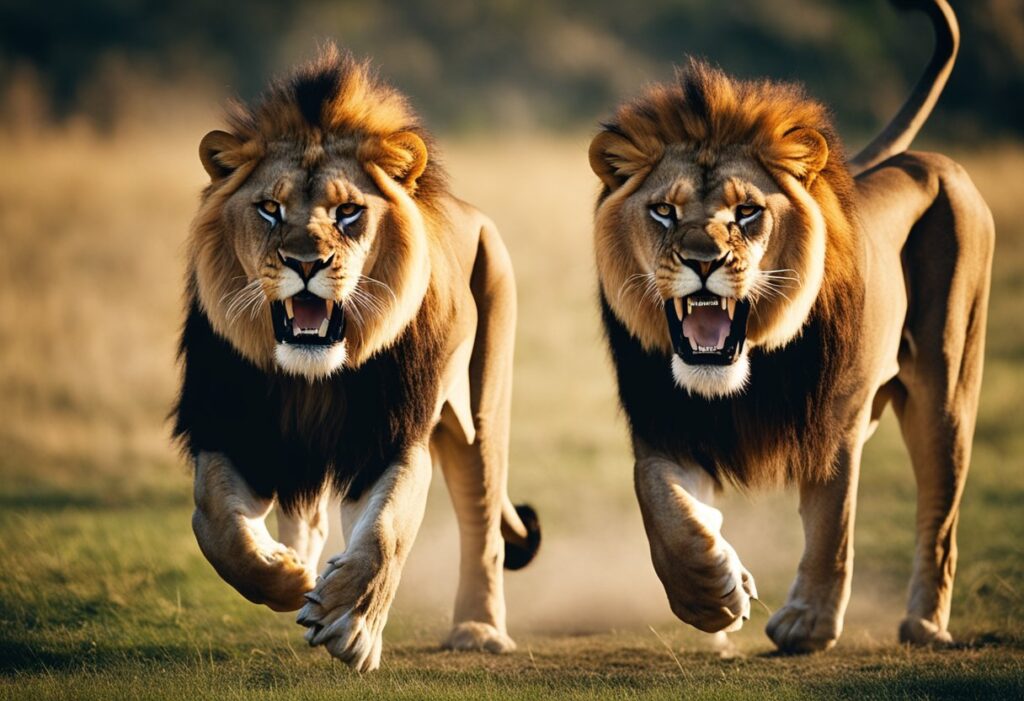
The African lion (Panthera leo) is a majestic big cat native to the grasslands and savannas of Africa. They are well known for their social lifestyle, unique among big cats, as they live in prides consisting of several females, their cubs, and a few dominant males. These formidable carnivores play an essential role in maintaining the balance of their ecosystem by controlling the population of their prey, such as zebra and buffalo.
African lions exhibit sexual dimorphism – males tend to be larger than females and possess a distinctive mane that sets them apart. The mane, which varies in color and size, asserts dominance and attracts potential mates.
The female lions, or lionesses, are the pride’s primary hunters, working in unison to bring down prey. Cubs are born dependent on their mothers and require roughly two years to become independent, learning essential life skills like hunting from their pride members.
The roar of an African lion, echoing across the savanna, is an iconic sound symbolizing the wild spirit of Africa. This powerful vocalization can reach 114 decibels, communicate with other lions, ward off potential rivals, and reinforce the pride’s territorial boundaries.
African lions face significant threats in their natural habitat due to human activity. Habitat loss, retaliatory killing due to livestock depredation, and poaching are all factors that contribute to the decline of lion populations.
Conservationists, governments, and communities are working to find solutions that promote coexistence between humans and these remarkable carnivores, ensuring their survival for future generations.
Dwindling Lion Population
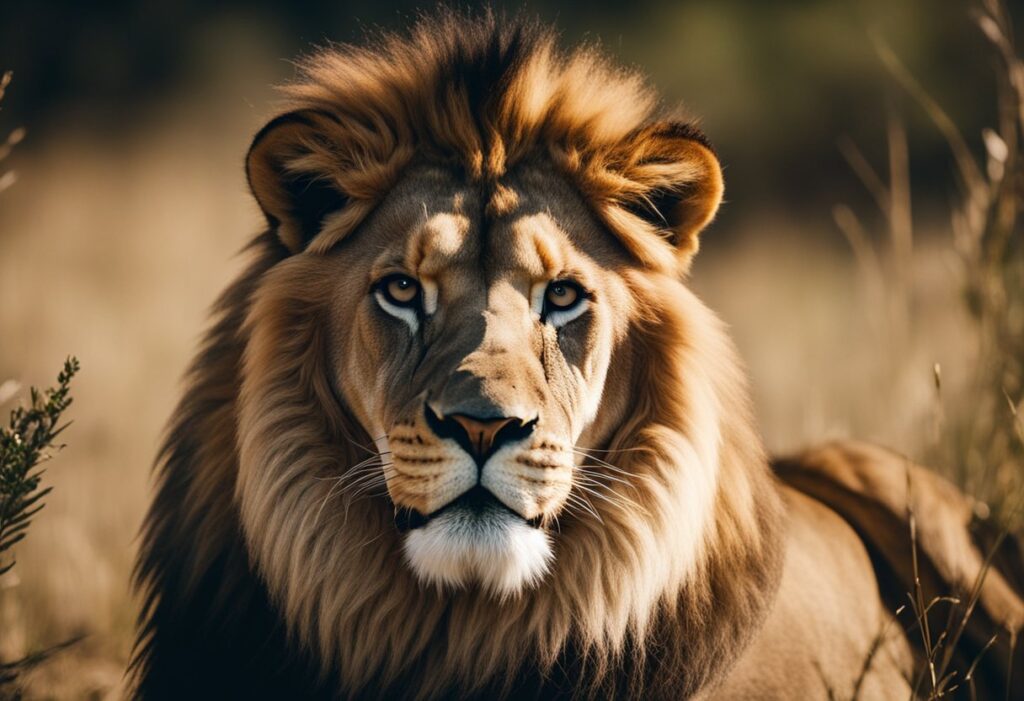
The African lion population is rapidly declining, posing a serious threat to their long-term survival. Sub-Saharan Africa is experiencing a significant drop in lion numbers, with the situation being worse in West Africa, where they are presently considered critically endangered.
South Africa is not immune to the decline either, as in both countries, their dwindling population is attributed to numerous factors, including habitat loss, human-wildlife conflict, and poaching.
A major factor contributing to this decline is the loss of suitable lion habitat. As human populations expand and occupy territories previously inhabited by lions, this large predator is pushed further into fragmented, less-ideal landscapes. The resulting reduction in prey availability and increased human-lion conflict tremendously strain lion populations.
Additionally, increasing human settlements in Sub-Saharan Africa have intensified human-wildlife conflict. Villagers perceive lions as a threat to livestock and their livelihood, making them a target for retaliatory killings. This issue not only reduces the lion population directly but also fragments their territories, isolating smaller groups and increasing their vulnerability to extinction.
Another crucial factor threatening the existence of the African lion is poaching. Over-exploitation of lions as trophy animals and illegal hunting for consumption and medicinal purposes are exacerbating their decline. The indiscriminate nature of poaching often leads to the destruction of entire lion prides, further stressing the populations to the point of being considered at risk of extinction.
Threats in Agriculture and Settlements

The expansion of human settlements and agriculture poses a significant threat to lion populations. The conversion of wildlife areas into agricultural fields leads to habitat loss and fragmentation, forcing lions to venture into proximity to human settlements.
Human-lion conflicts are exacerbated by the proximity of domestic animals, particularly livestock. Lions often find easy prey in cattle and other grazing animals, resulting in retaliatory killings by herders 2. Additionally, the presence of human populations in these areas increases the likelihood of lions entering villages and agricultural fields, putting human lives at risk.
Attempts to mitigate these threats involve implementing measures such as restricting agricultural expansion in wildlife areas and promoting the coexistence of humans and lions. Efforts have been suggested to educate communities on the importance of lions in the ecosystem and create buffer zones between wildlife areas and human settlements.
Nevertheless, promoting and implementing such measures is hindered by the need for agricultural development and the challenges posed by increasing human populations.
Despite these difficulties, it remains crucial to identify and implement effective strategies to minimize lion-human conflicts and ensure the long-term survival of lion populations across Africa.
See Related: Best Bear Sprays: Top Choices for Safety in the Wild
Poaching and Illegal Trade
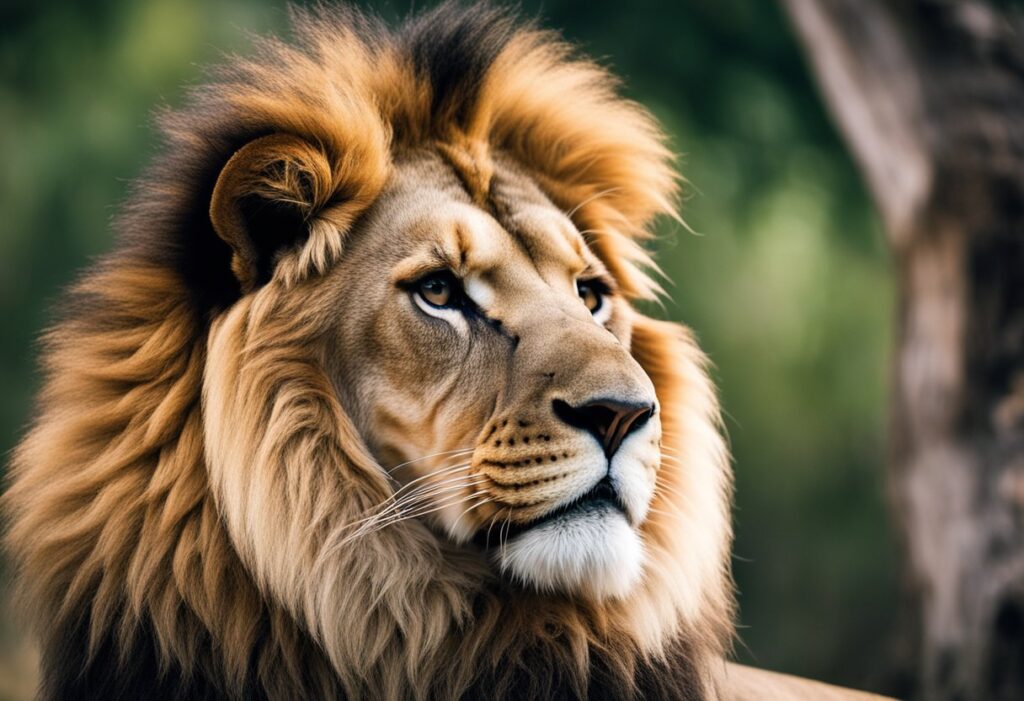
One of the major threats to lion populations is poaching, which can be motivated by diverse factors. Demand for lion body parts is a significant driver, with some regions experiencing targeted poaching of lions for body parts. Teeth and claws are particularly sought-after in illegal markets, often serving as status symbols or ingredients in traditional medicines.
Bushmeat poaching is another detrimental factor affecting lion populations. This practice involves hunting wild animals for food and is often driven by poverty and a lack of alternative protein sources. Unfortunately, lions are sometimes caught as bycatch in wire snares for smaller species.
Also, the decline in prey populations due to bushmeat poaching can negatively impact lion populations, leading to increased human-lion conflicts as lions are forced to prey on livestock.
The illegal trade in lion parts further exacerbates the issue of poaching. For instance, lion skins are sold for decoration, while bones and other parts may be used in traditional medicines, especially in the Asian market. The increase in internet access across some regions has allowed illegal trade to flourish online despite efforts taken by countries to combat the poaching and illegal trade of endangered species.
Efforts to address poaching and illegal trade are crucial for the conservation of lions, as these factors contribute significantly to their declining populations. Only by addressing these threats can we hope to protect and conserve this iconic species for future generations.
Conservation Challenges and Efforts

Lions face numerous conservation challenges, including habitat loss, human-lion conflict, and targeted poaching for body parts. Efforts by conservationists such as Peter Lindsey and Shivani Bhalla have helped address these threats by advocating for robust wildlife management strategies and the creation of protected areas.
One of the main challenges confronting lion populations is habitat loss and fragmentation. Wild landscapes are converted into agricultural and urban spaces as human populations grow and expand. This leads to shrinking habitats for lions, straining the available resources and making it harder for them to find food, shelter, and mates.
Human-lion conflict is another significant concern. As lion habitats become more scarce, these large predators are forced to venture closer to human settlements to find food, often resulting in livestock predation. This leads to economic losses for farmers and contributes to a negative perception of lions, which can result in retaliatory killings.
Targeted poaching for body parts has emerged as a new threat to lion conservation. In some regions, lion bones and other body parts are sought after for traditional medicine or as symbols of status and wealth. This illegal trade can devastate lion populations struggling with habitat loss and human-wildlife conflicts.
Conservationists like Peter Lindsey and Shivani Bhalla have worked tirelessly to address these challenges. Their primary focus is promoting effective wildlife management policies such as habitat restoration, creating corridors for wildlife movement, and establishing protected areas 5. Additionally, they work with local communities to develop sustainable livelihoods that reduce reliance on wildlife resources and mitigate human-lion conflicts.
Human-Lion Conflict

Human-lion conflict is a significant threat to lion populations worldwide. As human settlements expand to lion habitats, interactions between the two species become unavoidable. Subsistence farmers and livestock owners suffer losses from lion predation, eventually retaliating with various methods such as trapping, shooting, or poisoning lions.
To mitigate human-lion conflict, several strategies have been developed. One such method is the implementation of early warning systems like using lion satellite GPS collars to monitor lion movements and alert communities of their presence. This way, both humans and livestock can be secured from potential encounters with lions.
Another approach involves community engagement and sustainable solutions that offer alternative sources of income to reduce dependency on wildlife and natural resources. Through these efforts, communities become more invested in lion conservation and threat mitigation. For instance, ecotourism and other wildlife-related activities can create jobs and generate income for locals while enhancing their awareness of the importance of protecting lion populations.
However, addressing human-lion conflict requires considering various communities’ cultural differences and beliefs. Some cultures view lions as symbols of strength and power.
Thus, their encounters or conflicts with lions may carry a deeper meaning. Acknowledging these perspectives and working with local communities to find culturally sensitive and sustainable solutions will lead to more successful human-lion conflict management and mitigation efforts.
Additional Threat Factors

Lions face various challenges, some of which stem from direct human actions and others linked to broader environmental changes. One significant factor is the rapid pace of development, leading to habitat destruction and fragmentation.
Expanding human settlements, agriculture, and mining projects encroach upon lion habitats, reducing these predators’ available space and food sources. Additionally, this proximity creates opportunities for increased human-wildlife conflict as lions may prey upon livestock or threaten human safety, resulting in retaliatory killings.
Further intensifying the struggle for survival is the spread of disease among lion populations. Widespread outbreaks of diseases such as canine distemper and feline immunodeficiency virus can decimate local populations and weaken the overall genetic health of the species. Climate change also imposes indirect threats, altering ecosystems and shifting prey distribution patterns, which can negatively impact lion populations.
Hunting plays a complex role in the decline of lions. While trophy hunting contributes to population decline and social disruption, well-regulated hunting practices can generate revenue for conservation efforts, potentially aiding in protecting lion habitats. However, the risks of overhunting and illegal poaching activities remain constant.
In areas where poverty and resource insecurity are prevalent, human-wildlife conflict and hunting for bushmeat can further strain lion populations. Mitigating these issues requires addressing the root causes of poverty and improving community-based conservation initiatives, helping to foster a more sustainable coexistence between humans and lions.
Lastly, competition between lions and other large carnivores such as hyenas and leopards can impact lion population dynamics. This competition for limited resources, coupled with the various human-related pressures, adds strain on the already endangered species.
See Related: Dambari Wildlife Trust
The Lion’s Prey
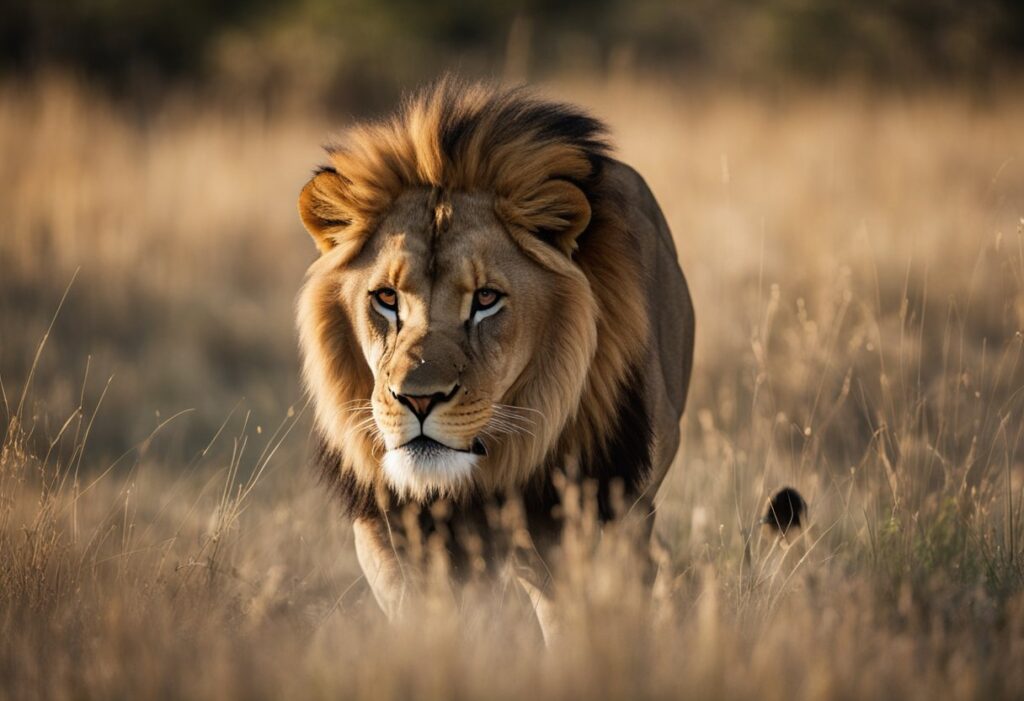
Lions, as apex predators, rely on a variety of wild prey species to maintain their populations. Their diet primarily consists of medium to large-sized herbivores, with antelopes and zebras being the most common prey items. Understanding the dynamics of these prey populations is essential to conserve and manage lion populations effectively.
Antelope species, such as impalas, play a significant role in the lion’s diet, offering a substantial source of sustenance. Impalas are known for their agility and ability to evade predators. In response to the threat of predation, they exhibit behavioral adaptations, including higher vigilance when in proximity to lions; this allows them to detect and escape from potential threats more effectively.
Zebras, another essential component of the lion’s prey base, are characterized by their strong and social nature. Their herd behavior and unique striping patterns help them to confuse and deter predators, making it more challenging for lions to single out and capture an individual.
Observations of zebra’s behavior suggest that their spatial distribution is influenced by water dependency, which can affect the likelihood of encountering lions.
The relationships between lions, antelopes, zebras, and other prey species are complex and continuously evolving. Studies have shown that variations in prey behavior, particularly regarding habitat use and risk avoidance, ultimately influence predator-prey interactions. Additionally, the vulnerability of lion’s prey species to climate change, habitat fragmentation, and human encroachment can threaten predator-prey dynamics and the broader ecosystem.
Understanding the connections between lions and their prey is crucial for conserving these species and their ecosystems. By continually studying and monitoring these relationships, researchers can better inform management practices and intervention efforts to ensure the long-term survival of both predators and their prey.
Impact on Other Wildlife

Lion populations play a significant role in maintaining the balance of African ecosystems. As apex predators, lions help control populations of herbivores such as elephants, which are vital for shaping landscapes and preventing overgrazing. However, when lion populations decrease, the balance among other wildlife species is often disrupted.
For instance, the decline in lion populations can lead to an increase in other large carnivores, such as cheetahs and leopards. These species may experience heightened competition and conflict as they navigate the same hunting territories). Similar patterns have been observed among African wild dogs, which face increasing pressure from lions and have to alter their denning habits to avoid lion-dominated areas, ultimately affecting their prey densities and survival rates.
In contrast, the decline in lion populations may have indirect negative effects on other wildlife. For example, with fewer lions to control herbivore populations, the balance of ecosystems can be disrupted. This can lead to overgrazing and deforestation, negatively impacting various animal and plant species and their habitats.
Furthermore, successful lion conservation efforts can enhance ecosystems’ overall health and resilience. Fencing, for example, has shown positive effects on conservation outcomes for lions and their prey, contributing to the stability and functionality of protected areas.
See Related: Most Populated Animals in the World
Lion Behaviour and Lifestyle
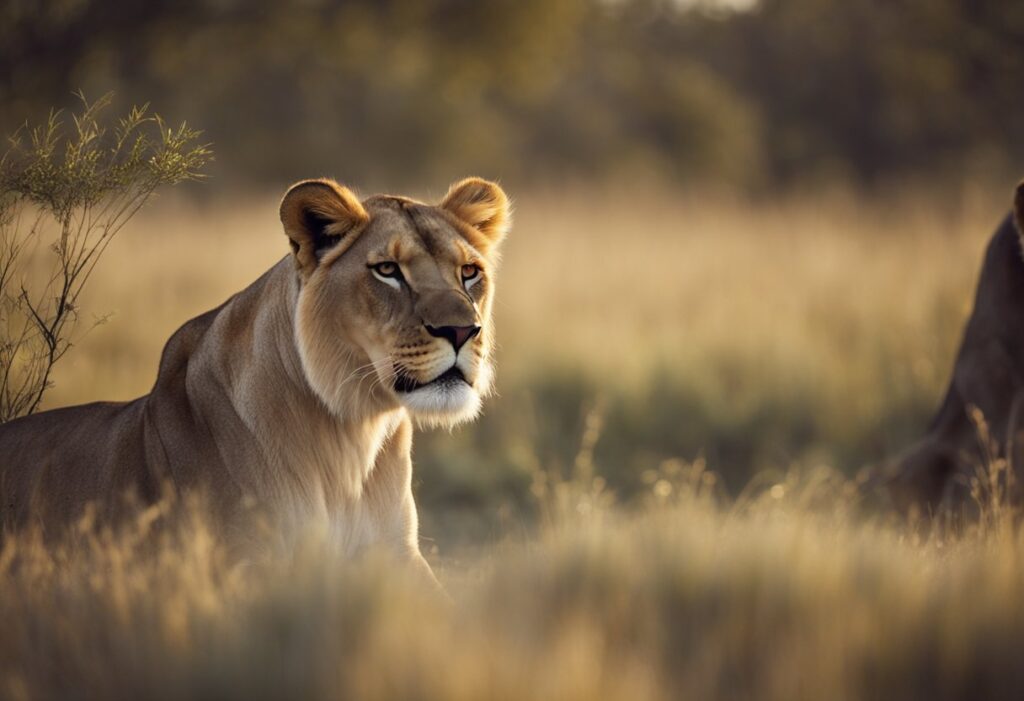
Lions live in groups called prides, which consist of several lionesses, their offspring, and a dominant male or a coalition of males. This social structure allows lions to hunt, defend territory, and raise their young effectively. Each pride occupies a territory that provides essential resources, such as food and water, for the pride members to survive and thrive.
The lionesses play a crucial role in the pride’s dynamics. They are the primary hunters, working together to capture prey. They also care for and teach the young cubs the necessary skills to survive in the wild. Through collaboration and teamwork, lionesses ensure the pride’s stability and well-being.
Regarding sleep, lions are known for their extensive rest periods. On average, lions spend about 20 hours a day resting, which is crucial to conserve energy for their brief but intense bursts of activity during hunting or territorial defense.
Power and courage are key traits of lions. As apex predators, they are built for strength and endurance. Male lions are particularly recognized for their power, as they are responsible for defending the pride’s territory from rival males and other threats. Demonstrating courage, lions often face and fend off competitors, such as hyenas, to minimize risk to their pride members and maintain their dominance in the region.
Lions display an intensity when hunting as they relentlessly pursue their prey. Despite their size, their silent and nimble movements give them an advantage in stealth and ambush tactics, further proving their skill and dominance over prey species.
Related Resources:
- The Iconic Animals in Lion King… Explored!
- Do Lions Eat Elephants? Here’s What to Know
- Do Lions Live in the Jungle? Learn Where They Live


